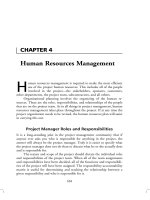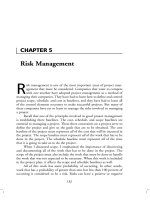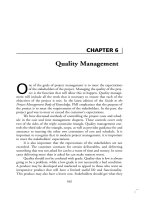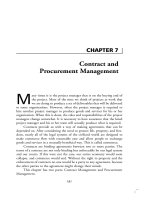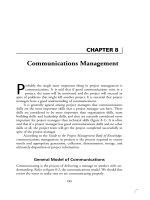Tài liệu Project Management Professional-Chapter 7 doc
Bạn đang xem bản rút gọn của tài liệu. Xem và tải ngay bản đầy đủ của tài liệu tại đây (144.03 KB, 14 trang )
CHAPTER 7
Contract and
Procurement Management
M
any times it is the project manager that is on the buying end of
the project. Most of the time we think of projects as work that
we are doing to produce a set of deliverables that will be delivered
to some organizations. However, often the project manager is required to
hire another project manager to produce goods and services for his or her
organization. When this is done, the roles and responsibilities of the project
managers change somewhat. It is necessary to have assurance that the hired
project manager and his or her team will actually produce what is required.
Contracts provide us with a way of making agreements that can be
depended on. After considering the need to protect life, property, and free-
dom, nearly all of the legal systems of the civilized world are designed to
make commerce flow with reasonable ease and allow people to exchange
goods and services in a mutually beneficial way. This is called commerce.
Contracts are binding agreements between two or more parties. The
terms of a contract are not only binding but enforceable by our legal system
and our courts. If this were not the case, our entire economy would soon
collapse, and commerce would end. Without the right to property and the
enforcement of contracts no one would be a party to any agreement, because
the other parties to the agreement might change their minds.
This chapter has two parts: Contract Management and Procurement
Management.
181
182 Preparing for the Project Management Professional Certification Exam
Contract Management
The first thing we should have is a definition of a contract. Texts on business
law define a contract as follows: A contract is an agreement between compe-
tent parties, for consideration, to accomplish some lawful purpose with the
terms clearly set forth.
First of all, the contract is an ‘‘agreement.’’ This means that the parties
involved must have a meeting of the minds and decide that they will do the
things set forth in the contract. By this definition no contract can be forced
on someone. If any kind of forcing or coercion is done, there cannot be an
enforceable contract. You cannot force someone at gunpoint to sign a con-
tract to buy aluminum storm windows and expect to hold the person to the
contract.
The contract must be ‘‘between competent parties.’’ This means that
the people that make the agreement must be competent to make the agree-
ment. Persons that are impaired in any way that makes them unable to make
responsible decisions or people who are not of age are not able to make
contracts. As a matter of fact, if a minor or another incompetent party enters
into a contract, the contract may be enforceable on the competent party and
not on the incompetent party.
The contract must be ‘‘for consideration.’’ This means that something
must be given for something else. If there is no exchange of anything, then
there is no contract. There would be no point in going to the trouble to
create a contract if there is no exchange. It is important to note that the
consideration does not have to be something that is valuable to everyone.
The consideration could easily be something that one person values and no
one else does. The consideration does not need to be tangible either. An
intangible consideration can be involved in any contract.
The contract must ‘‘accomplish some lawful purpose.’’ No contract can
legally be written that violates the law. You cannot contract with someone
to steal a car for you. The contract would be void at its inception.
In discussing contract management for projects we generally are inter-
ested in the relationship between a buyer and a supplier.
Make or Buy
The decision to make or buy something must be considered. Many times it
is less expensive to purchase something from an outside source than it is to
make the item inside the company. Cost is a major consideration for this,
but there are many other reasons for deciding whether to purchase or make
.......................... 9618$$ $CH7 09-06-02 14:59:39 PS
TEAMFLY
Team-Fly
®
183Contract and Procurement Management
an item. If a facility has idle capacity, it may be favorable to make a part that
is normally made by an outside vendor. The excess capacity is there to be
used, and the company is paying for it whether it is used or not. In a make
or buy decision, it should only be necessary to consider the variable cost in
this situation. If there is no extra capacity, then the cost of adding the capac-
ity must be considered as well.
If an item is needed and it is important that strict control be maintained
in its production, it may be necessary to make the item instead of purchasing
it. Similarly, items that involve trade secrets and innovative products should
not be contracted out of the company.
Using the flexibility of the purchasing system to stabilize the workforce
is desirable. Many companies have used this strategy to help maintain consis-
tent employment levels in their companies. A company wishing to do this
subcontracts some of the work to outside companies. When the demand for
its product goes down, the company decreases the amount of work that the
outside contractor is doing and maintains the constant level of work in its
own facility. It does not take vendors long to figure this out and adjust
pricing for the product to compensate them for their own stability problems.
Deciding to purchase an item may simply be a matter of a company
not having the ability to produce the item. Skills may be unique for this
projected and may not be needed in the future. Buying equipment that will
be needed only for this project may not be justifiable, and it may be less
costly to buy the items in question.
Contract Life Cycle
The contract life cycle must be managed like the project life cycle. The
contracting process is very similar to the project management processes of
initialization, planning, implementation, and closeout.
In the contracting process, we consider the steps in a little more detail
(figure 7-1). The requirement stage of the contracting process can be consid-
ered equivalent to the initialization of the project. The requisition, solicita-
tion, and award stages can be considered equivalent to the planning process.
The contract can be considered equivalent to the implementation process.
Closeout occurs at the close of the contract.
Requirement Process
In the requirement process the needs of the project are identified. As in
the requirements definition of the project, the requirements of the contract
are identified. These requirements come from a needs assessment, and the
.......................... 9618$$ $CH7 09-06-02 14:59:40 PS
184 Preparing for the Project Management Professional Certification Exam
Figure 7-1. Contracting process life cycle.
Requirement
Requisition
Solicitation
Award
Contract
needs are further reduced to requirements. Before the decision to purchase a
good or service is made, a decision must be made as to whether the item
should be purchased or made internally. Requirements are frequently stated
in a document called the statement of work.
Cost estimates must be produced to help predict what the correct cost
of the item should be. These cost estimates help the person doing the pur-
chasing to determine whether or not the potential vendor is quoting a fair
and agreeable price.
As in the project management requirements definition, the process be-
gins with a determination of needs. These are the items that someone wishes
to have delivered. These needs are reduced by mutual agreement to require-
ments. The requirements are further reduced by excluding the requirements
that are not justified.
Requisition Process
The requisition process consists of reviewing the specifications and
statement of work and identifying qualified suppliers. It is sometimes called
solicitation planning.
During the requisition process, the requirements definition is passed to
the purchasing personnel. These may or may not be part of the project team.
The specifications and statement of work are reviewed, but now there is
input from the purchasing function. This input provides cost information
.......................... 9618$$ $CH7 09-06-02 14:59:41 PS
185Contract and Procurement Management
that may further reduce the requirement of items that are now deemed to be
impractical.
At this time all of the signatures necessary to procure the item are added
to the requisition. Certain signatures are required before the company can
be committed to make an expenditure and other signatures are necessary to
be sure that all necessary persons are informed about the purchase being
made.
Solicitation Process
The solicitation process involves obtaining bids or proposals. During
this process a selection of vendors is solicited to participate in the process of
becoming the chosen vendor. In the case of commodity purchases it may
only be necessary to evaluate the price of the item being supplied. In the
case of unique items it may be necessary to evaluate many different aspects
of the vendor and the product that is proposed.
Award Process
During the awarding process, one vendor is selected from the ones
solicited. At this time the contract is written, negotiated, and signed by both
parties.
The writing and signing of the contract can be simple, as in the pur-
chase of a commodity. In the purchasing of such common items the contract
is generally a standard item that is written on the back of a purchase order.
Many times these contracts are written in very light ink and in very small
type.
In more complex purchases, the contract may have to be negotiated,
and specific terms and conditions for this particular contract must be agreed
to. The more detailed the contract, the more complex this part of the con-
tracting cycle will be.
Contract Process
The contracting process is the final part of the contracting process. In
this process the contract is actually carried out. The vendor and the pur-
chaser must follow the planning process, organize the work staff for the work
to be done, and control the contract. The purchaser and the seller must both
be responsible for their part of the contract.
Contract Types
In the world of commerce nearly any kind of agreement can be made that
will satisfy the needs of both parties of the contract. Whenever there is a
.......................... 9618$$ $CH7 09-06-02 14:59:42 PS




